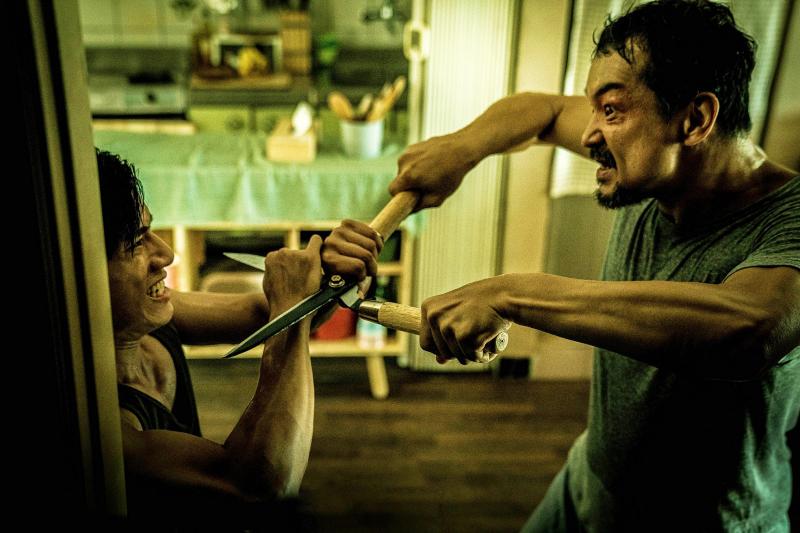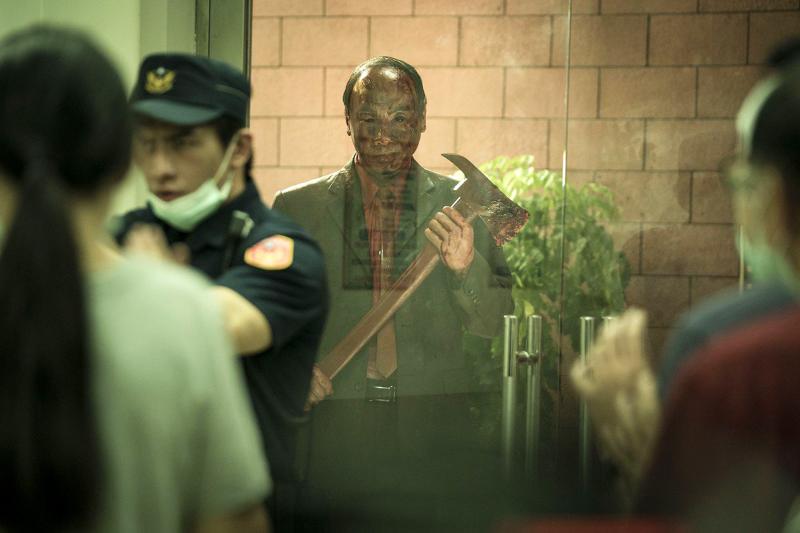If you’re squeamish about intentionally campy, senselessly gory zombie-style bloodfests, stay away from this film.
This reviewer is no fan of the genre, but somehow, between the smooth production, excellent death metal-meets Taiwanese temple music soundtrack, fast paced action and not-so-subtle digs at the government and humanity, The Sadness (哭悲) proved to be mildly entertaining.
The social parody is not as relentless and biting as last August’s Get The Hell Out (逃出立法院), where the nation’s entire legislative body transforms into zombies, but that one was somewhat bogged down by very specific Taiwanese cultural references that could only be appreciated by a familiarity with the nation’s pop culture and sociopolitical events. You don’t need to know that much to understand The Sadness, just sit back and enjoy the crazy rampages and flying guts.

Photo courtesy of iFilm
Set in an anti-Taiwan where the government has chosen to downplay and ignore the potential effects of an ongoing “Alvin Virus” pandemic despite warnings from leading virologists, the virus suddenly mutates and starts turning people into sadistic, bloodthirsty, cannibalistic and lustful maniacs.
What’s interesting here is that the infected still retain their sentience and control over their bodies. They’ve just completely given into their worst tendencies and desires — which makes them way creepier and more dangerous than the typical brainless, bumbling zombie. Even worse, a virologist suggests at one point that they may still be aware of what they’re doing, they just can’t control it anymore — it’s like fighting the urge to blink, he says.
The film opens with lead couple Jack (Berant Chu 朱軒洋) and Kat (Regina,雷嘉納), who are separated when Kat heads to her job in Taipei and Jack stays in their cozy Keelung home. The violence erupts across Taiwan shortly after, and the two try to find each other amid the chaos. That’s about it to the plot (and their relationship) and there’s almost no character development or depth, but director Rob Jabbaz does a decent job in using extreme effects, eerie moods and disturbing dialogue and behavior to carry the film through.

Photo courtesy of iFilm
While Hollywood zombies have most aspects of their humanity removed as they commit their carnage, the infected lunatics here are driven by their all-too-human darker sides. For example, Kat’s primary pursuer (Wang Tzu-chiang, 王自強) is fixated on her since she rejected his advances earlier on the MRT. This is the common theme that emerges from the bloodbath and gives the viewers at least something to, um, chew on.
There’s not much acting skill needed to portray the terrorized and panicking “good guys” in such a film and the two leads do a satisfactory job (it’s Regina’s feature debut). And while some may complain that the behaviors of the infected are too crass and inappropriate, the point of the film is to exaggerate the vileness buried in our hearts.
Kudos to IF SFX Art Maker (覺藝工作室特效化妝) for the special effects (they also worked on Get The Hell Out among other movies). They’ve managed to even make the most extreme scenes look believable and not cheesy, which is something that could make or break the film.
This kind of film is not meant to make much logical sense, and although there are some questionable points, what’s presented is watchable enough. But shiny production, an intriguing concept and a willingness to go beyond what’s normally acceptable isn’t what makes a movie memorable. There’s tons of potential — and value — here, but the oversimplified plot and lack of attention to storytelling nuances and details is notable.

The 1990s were a turbulent time for the Chinese Nationalist Party’s (KMT) patronage factions. For a look at how they formed, check out the March 2 “Deep Dives.” In the boom years of the 1980s and 1990s the factions amassed fortunes from corruption, access to the levers of local government and prime access to property. They also moved into industries like construction and the gravel business, devastating river ecosystems while the governments they controlled looked the other way. By this period, the factions had largely carved out geographical feifdoms in the local jurisdictions the national KMT restrained them to. For example,

With over 100 works on display, this is Louise Bourgeois’ first solo show in Taiwan. Visitors are invited to traverse her world of love and hate, vengeance and acceptance, trauma and reconciliation. Dominating the entrance, the nine-foot-tall Crouching Spider (2003) greets visitors. The creature looms behind the glass facade, symbolic protector and gatekeeper to the intimate journey ahead. Bourgeois, best known for her giant spider sculptures, is one of the most influential artist of the twentieth century. Blending vulnerability and defiance through themes of sexuality, trauma and identity, her work reshaped the landscape of contemporary art with fearless honesty. “People are influenced by

April 14 to April 20 In March 1947, Sising Katadrepan urged the government to drop the “high mountain people” (高山族) designation for Indigenous Taiwanese and refer to them as “Taiwan people” (台灣族). He considered the term derogatory, arguing that it made them sound like animals. The Taiwan Provincial Government agreed to stop using the term, stating that Indigenous Taiwanese suffered all sorts of discrimination and oppression under the Japanese and were forced to live in the mountains as outsiders to society. Now, under the new regime, they would be seen as equals, thus they should be henceforth

The remains of this Japanese-era trail designed to protect the camphor industry make for a scenic day-hike, a fascinating overnight hike or a challenging multi-day adventure Maolin District (茂林) in Kaohsiung is well known for beautiful roadside scenery, waterfalls, the annual butterfly migration and indigenous culture. A lesser known but worthwhile destination here lies along the very top of the valley: the Liugui Security Path (六龜警備道). This relic of the Japanese era once isolated the Maolin valley from the outside world but now serves to draw tourists in. The path originally ran for about 50km, but not all of this trail is still easily walkable. The nicest section for a simple day hike is the heavily trafficked southern section above Maolin and Wanshan (萬山) villages. Remains of